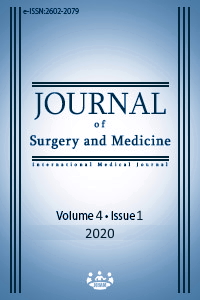Prevalence of human pseudocholinesterase (butyrylcholinesterase) deficiency in central Anatolian people: A cross-sectional study
Keywords:
Human butyrylcholinesterase, Central Anatolian people, Pseudocholinesterase deficiency, SuccinylcholineAbstract
Aim: Human pseudocholinesterase (PChE) is an enzyme responsible for hydrolysis of the muscle relaxant drugs like succinylcholine and mivacurium. PChE deficiency, which may lead to prolonged apnea, may occur due to hereditary or acquired causes. In our study, we aimed to investigate the prevalence of human pseudocholinesterase (PChE) enzyme deficiency around the central Anatolia region and present our results in light of the literature.
Methods: This cross-sectional study included 936 patients (age 18-70 years) who underwent any elective surgery under general anesthesia between August 2015 and September 2019. Human PChE level, plasma PChE activity, the human PChE activity/albumin, serum liver and kidney function tests were analyzed from blood samples. Human PChE enzyme deficiency and possible association of the PChE deficiency with other values was also investigated. The normal value of PChE was considered to range from 4650 U/L to 10,440 U/L.
Results: PChE activity was decreased in 19 (1.9%) of the 936 patients (442 males and 494 females). There was no statistically significant difference between the PChE levels in terms of gender (P=0.236). The mean human PChE activity of all patients was 7.490 (0.980). The PChE activity of 22 (2.35%) and 58 patients (6.4%) were below 5.000 U/ml and 6.000 U/, respectively. A statistically significant difference was found between serum urea, creatinine and human PChE levels (P=0.034, P=0.236, respectively). However, PChE deficiency had no correlation with liver function tests such as AST and ALT (P=0.432, P=0.022, respectively).
Conclusion: PChE deficiency can be observed in preoperatively evaluated patients and may cause serious life-threatening conditions, including respiratory failure and prolonged apnea.
Downloads
References
Andersson ML, Møller AM, Wildgaard K. Butyrylcholinesterase deficiency and its clinical importance in anaesthesia: a systematic review. Anaesthesia. 2019 Apr;74(4):518-28.
Wichmann S, Færk G, Bundgaard JR. Patients with prolonged effect of succinylcholine or mivacurium had novel mutations in the butyrylcholinesterase gene. Pharmacogenet Genomics. 2016;26:351–6.
Whittington JE, Pham HD, Procter M, Grenache DG, Mao RA. Patient with prolonged paralysis/commentary/commentary. Clinical Chemistry. 2012;58(3):496-500.
Liu QC, Chen F, Wu CY. CALCB splice region pathogenic variants leading to plasma cell neurotropic enrichment in type 1 autoimmune pancreatitis. Cell Death Dis. 2017;8:e2591.
Stoelting RK, Hiller SC. Pharmacology and physiology in anesthesia practice (5th ed.). Philadelphia: Lippincott, Williams, & Wilkins, 2015.
Zhang C, Cao H, Wan ZG, Wang J. Prolonged neuromuscular block associated with cholinesterase deficiency. Medicine (Baltimore). 2018 Dec;97(52):e13714.
Soliday FK, Conley YP, Henker R. Pseudocholinesterase deficiency: A comprehensive review of genetic, ac¬quired, and drug influences. American As¬sociation of Nurse Anesthetists Journal. 2010:78(4):313-20.
Schmidt E, Henkel E, Klauke R, Lorentz K, Sonntag O, Stein W, et al. Proposal for standard methods for the determination of enzyme catalytic concentrations in serum and plasma at 37 degrees C. J Clin Chem Clin Biochem. 1990;28:805-8.
Yıldırım S, Şahin AF, Döngel İ, Erşan İ. Sivas ilinde psödokolinesteraz eksikliği görülme sıklığı ve ilişkili klinik parametreler. Turkiye Klinikleri J Anest Reanim. 2012;10:84-8.
Dooley M, Lamb HM. Donepezil: a review of its use in Alzheimer's disease. Drugs Aging. 2000 Mar;16(3):199-226.
Hackett PJ, Sakai T. Pseudocholinesterase deficiency: a case report and literature review. Open J Anesthesiol. 2012;2(4):188-94.
Thomsen JL, Nielsen CV, Eskildsen KZ, Demant MN, Gätke MR. Awareness during emergence from anaesthesia: significance of neuromuscular monitoring in patients with butyrylcholinesterase deficiency. Br J Anaesth. 2015 Jul;115 Suppl 1:i78-i88.
Alvarellos ML, McDonagh EM, Patel S, McLeod HL, Altman RB, Klein TE. PharmGKB summary: succinylcholine pathway, pharmacokinetics/pharmacodynamics. Pharmacogenet. Genomics. 2015 Dec;25(12):622-30.
White SM. Pseudocholinesterase deficiency in specific populations. Eur J Anaesthesiol. 2012 Apr;29(4):211.
Zhang QL, Xu MJ, Wang TL. Newly discovered COLQ gene mutation and its clinical features in patients with acetyl cholinesterase deficiency. J Integr Neurosci. 2018;6
Zhou W, Lv S. Delayed recovery from paralysis associated with plasma cholinesterase deficiency. Springerplus. 2016;5(1):1887.
Pseudocholinesterase enzyme deficiency. Genetics Home Reference. April 2012. http://ghr.nlm.nih.gov/condition/pseudocholinesterase-deficiency.
Lurati AR. Organophosphate exposure with pseudocholinesterase deficiency. Workplace Health Saf. 2013 Jun;61(6):243-5.
Ellison M, Grose B, Howell S, Wilson C, Lenz J, Driver R. Prolonged Paralysis Following Emergent Cesarean Section with Succinylcholine Despite Normal Dibucaine Number. WV Med J. 2016 Mar-Apr;112(2):44-6.
Yu R, Guo Y, Dan Y, Tan W, Mao Q, Deng G. A novel mutation in the BCHE gene and phenotype identified in a child with low butyrylcholinesterase activity: a case report. BMC Med. Genet. 2018 Apr;19(1):58.
Naik B, Hirshhorn S, Dharnidharka VR. Prolonged neuromuscular block due to cholinesterase depletion by plasmapheresis. J Clin Anesth. 2002;14:381–4.
Geyer BC, Larrimore KE, Kilbourne J, Kannan L, Mor TS. Reversal of succinylcholine induced apnea with an organophosphate scavenging recombinant butyrylcholinesterase. PLoS One. 2013;8(3):e59159.
Checketts MR, Alladi R, Ferguson K, Gemmell L, Handy JM, Klein AA, et al. Recommendations for standards of monitoring during anaesthesia and recovery 2015: Association of Anaesthetists of Great Britain and Ireland. Anaesthesia. 2016 Jan;71(1):85-93.
Abdullayev R, Küçükebe OB, Kaya R, Çelik B, Kuşderci H. Pseudocholinesterase Enzyme Deficiency in Adıyaman City Area. Turk J Anaesthesiol Reanim. 2015 Dec;43(6):381–6.
Human (butrylcholinesterase) Pseudocholinesterase Deficiency. Mayo Clinic. April 18, 2016; http://www.mayoclinic.org/diseases-conditions/pseudocholinesterase deficiency/home/ovc-20200771.
Downloads
- 992 1385
Published
Issue
Section
How to Cite
License
Copyright (c) 2020 Muzaffer Gencer, Yeşim Göçmen
This work is licensed under a Creative Commons Attribution-NonCommercial-NoDerivatives 4.0 International License.
















